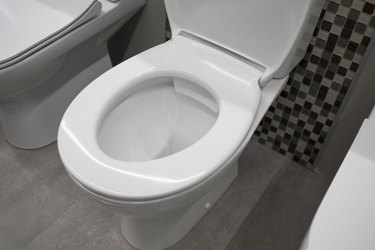
Toilet seats have to be replaced from time to time, and it only takes a few minutes in the best-case scenario. This DIY job can turn into a frustrating task when the nuts are corroded or deteriorated. If you have the proper tools and a little bit of patience, it doesn't have to turn into a homeowner's nightmare.
Plastic Toilet Seat Nuts
Video of the Day
The majority of toilet seats are attached to the toilet base with fittings that are held together with two bolts. Plastic caps behind the seats generally cover these. Pry open the bolt covers with the lid down to expose their heads. Check these bolts for any visible damage; if they are made of plastic, they cannot corrode. Over time, though, these plastic caps can deteriorate and become harder to remove.
Video of the Day
If it is the case that your plastic caps have deteriorated, use a flathead screwdriver to work around the cap to loosen it. Take extra care to use a gentle hand; otherwise, you could damage the toilet. Once the caps are off, you should see the top of the bolts and maybe wingnuts. These might also be made of plastic, and you may need to loosen these as well. Then, grip the nut underneath with a pair of pliers and unscrew the bolt with a flathead screwdriver.
Stubborn Toilet Seat Nuts
With older toilet seats, you may have to use a lubricant, like WD-40, to loosen them if they won't budge. Metal bolts can be harder to remove, and you will want to use a socket wrench equipped with a deep well socket; most toilet seats need a half-inch socket for this job. Fit this over the long bolt and it should grip the nut tightly. Turn it counterclockwise as hard as you can, and if some of the bolt breaks off, don't worry about it; you're replacing it anyway.
As a last resort, you might try to use a drill, but note that this is the most likely option to cause damage. Don a pair of safety glasses and insert a 1/16-inch bit into the drill. Then, drill a quarter-inch into that stubborn bolt where it meets the nut. Switch to a 1/8-inch bit and enlarge the hole; then, change that out for a 3/16 inch and make the hole larger. Try using the socket wrench again to break the bolt off as you turn the nut. You might have to keep enlarging the hole until the bolt breaks.
Buying a Replacement Toilet Seat
Standard toilet seats can work well enough, but upgrades can make a whole world of difference. If you go for an upgrade, make sure that you buy one that fits your toilet. There are basic round shapes plus elongated round, square and rectangular versions. Look for options like a quiet-close feature so that the toilet seat doesn't come crashing down loudly. Grip-tight bumpers are also good because they hold the seat firmly in place.
Cushioned seats are generally more comfortable than more rigid seats and can be easier to get on and off. Some of these have heavier bases for stability, with the padding integrated on top. You might want to spend extra on one of these because the inexpensive ones may be prone to cracks in the vinyl covering. Last and not least, look for toilet seats that are easy to remove and install. This way, you can take the whole thing off to clean it in your shower and won't have such a hard time replacing it when the time comes.